The Rhetorical Value of Online Communcation
Whether it is a chat room, video conferencing, or instant messaging, the manner and nature in which teachers interact with students is changing. In the book Multiliteracies for a Digital Age, Stuart Selber states that "for better or worse, computer environments have become primary spaces where much education happens" (Selber 3). While this may appear to be an obvious statement, current students spend a majority of their time interacting online with one another through instant messages or social networking sites. Rather than trying to pull students from an already familiar environment, it is far more plausible to meet them where they are most comfortable. Not only can communication and discussion take place online, but the avenue being taken becomes a part of that discourse. In an online environment, teachers are able to interact with students and examine a variety of subjects that can be discussed rhetorically.
Preparing Educators for Online Writing Instruction
While I have some experience of teaching online, and although I favor the use of technology in most situations depending on the specific needs of the student, I will always argue that online instruction can never replace face-to-face interaction. I say this for two reasons: 1) the spatial atmosphere of face-to-face cannot be replaced by a video screen or a chat room, and 2) if I truly believe online instruction will replace everything, then I will essentially be putting myself out of a job.
In the book Preparing Educators for Online Instruction: Principles and Processes by Beth L. Hewett and Christa Ehmann, the authors state they are not advocating “that online teaching and learning does or should replace face-to-face teaching and learning. Instead, we believe that online teaching and learning can work as a supplement and complement to that which occurs in face-to-face settings” (XIV–XV). This is a philosophy I have kept with me since the beginning of my teaching career.
Spacial Relations in the Digital Classroom
While both students and teachers enter face-to-face classrooms with pre-conceived notions of their place in the classroom, online classrooms do not have the same expectations of social presence. In the article “The Decentered Teacher and the Construction of Social Space in the Virtual Classroom” by Dorothea Anagnostopoulos, Kevin G. Basmadjian, and Raven S. McCrory, the authors use discourse-analysis to examine how teachers and students interact in an online classroom. Their analysis shows that for at least one online class, the asynchronous nature of discussion forums “allowed students to decenter the teacher and her authority” in the digital social space (1725). However, other synchronous forums allow the teacher to “reinscribe conventional classroom social relations” (1726). Thus, the online environment allows teachers and students to renegotiate the “space” of the classroom (I will explore this nature of synchronous and asynchronous communication later).
However, what is intriguing is the nature of this space. As David DiSarro points out in his Creative Writing Episodes, there is a difference in space not only between the author and the text, but between the reader and the text as well. Creatively speaking, this decentering of the teacher (or the authority) allows the author a chance to use technology and then gain feedback from the instructor (see examples below). While this may be either synchronous or asynchronous, the writer is able to use technology as a means to create the text as well as receive feedback.
Thus, technology supports two purposes: it serves as a medium that fosters creativity; and offers feedback and instruction. The spatial relation of the digital classroom allows the writer to create their own space and, over time, reconnect with the class to exchange ideas.
Online Writing Instruction: Best Practices

Given the increasing popularity of online writing instruction, the Conference on College Composition and Communication has created a committee to investigate and develop a set of best practices for online writing instruction. This committee is chaired by Beth Hewitt, the co-author of the book Preparing Educators for Online Instruction (discussed above).
So far, the committee has found that too much attention is paid to technical issues rather than writing issues. To emphasize this, in the article "Asynchronous Online Teaching," by Donald Wolf, the author states that his biggest problem with online instruction is his time wasted fixing technical problems (Wolf 446). As can be seen in the following points, part of what the committee has been charged to do is to assess the technical education of online writing instructors to alleviate this problem.
Here is what the committee has been charged to do:
1- identify and examine best strategies for online writing instruction in hybrid and distance-based composition classrooms;
2- identify best practices for using various online media and pedagogies (e.g., networked classrooms, e-mail and Internet-based conferences, peer-reviewed papers) for the teaching of writing with both synchronous and asynchronous modalities and taking into consideration currently popular learning management environments;
3- identify best practices for using online writing instruction for English language learners
4- identify best practices for training and professional development of online writing instructors.
5- file reports twice a year prior to the CCCC and NCTE conference meetings using the Report format; and compose a post for the CCCC web site that communicates your ongoing work. NCTE staff will see that your text is posted on your committee's behalf. ("Committee on Best Practices")
While I like every aspect of this doctrine, especially the notion of hybrid classrooms and proper training, the most intriguing part is the requirement to to file two reports per year. As fast as technology changes, it is no longer viable for writing instructors or educators of any kind to rethink their pedagogy every 4 or 5 years. Instead, they must rethink how they teach each semester if they are to stay on top of digital trends and the latest in writing technology. Any effort less than twice a year and I would question a teacher's commitment to his craft as well as his students.
Online Communication: Synchronous & Asynchronous
Donald Wolf appreciates several features of online education, such as the fact that all work is done in writing (Wolf 447). He concludes that students who read the online course material are paying attention and that “asynchronous courses enhance analytical discourse” (Wolf 447). I agree with Wolf's appreciation of online instruction because all of the work is done in writing, but the form and context of that writing may shift between what is deemed academic and what is not. The asynchronous nature of his classroom may enhance analytical discourse, but as discussed earlier, if there is a technical problem, the teacher may not get to it quickly - thus, while the server is down or the website is not working properly, valuable writing time is lost.
In the following video you can see the interaction between myself and David DiSarro. While we are conversing online and working on the same text, it is not as synchronous as one would guess. There is a delay, a hesitation caused by the technology that would not normally exist in a face-to-face meeting. I use the term asynchronous at the end of the video, but I feel the meaning of this word is not entirely what I want as well. If possible, perhaps I need to use the term "semi-synchronous" with concern for technology. There may come a time when there is no delay and information is instant, but until that day, I cannot fully admit the nature of our communication as being either synchronous or asynchronous. Thus, "semi-synchronous" is the best way to describe the interaction.
Regardless, the following video shows a way of interacting with students using VOIP (Voice Over Internet Protocol) - the software being used for this is Skype, a VOIP application that lets people talk to one another for free via video-conferencing. In conjunction with this, we are also using GoogleDocs - a web based document system that allows two people to edit the text at the same time. As you can see in the video, if students use Skype or GoogleDocs, the instructor can have online conferences and discuss papers from any discipline, be they creative, rhetorical, etc. While it cannot supplant face-to-face interaction, the visual display of the face and the sound of the voice can help to alleviate any hesitation the student may feel.
Working With Students Online

There are a few programs that contain alphabetical text with video and sound such as Adobe Captivate 4 and Sophie, but the use of Camtasia is interesting because after you videotape your discussion of the student’s paper, you can save it as a movie file. It is not a Word Document or a paper, it is a form of media that contains your feedback along with your image and voice – all in one file. In essence, it becomes a multimodal composition.
Just as the previous Skype video is able to show my face during the discussion, here, taped into the video file along with my comments and track changes are my face and voice. It is an asynchronous approach towards communicating with students rather than just handing back their paper with a few comments on it. Here, the instructor is able to create a sense of communication that deals with multiple modes and conveys the feelings and passions that may be lost in written comments, but more easily conveyed through human sight and sound.
In the following video, this multimodal communication is taken to new heights as I demonstrate the ability to extract a sense of structure from a chat interface with a student and lead it into an organization scheme further developed in Microsoft PowerPoint.
Final Thoughts on Online Communication
As I have stated before, I do not believe that online communication will fully replace face-to-face interaction. I suggest a more hybrid approach, one echoed by the NCTE and their committee on best practices for Online Writing Instruction. But I feel this can be applied to all disciplines, including creative writing, literature, architecture, the sciences, etc. The incorporation of multimodal texts and the means by which we can communicate with our students should not impede our pedagogy—rather, it should infuse it.






